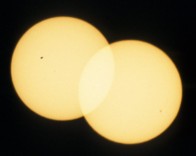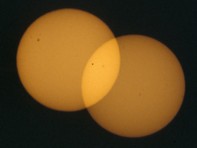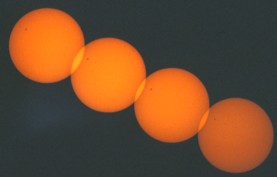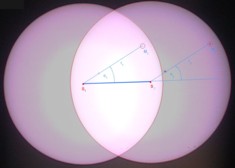 Essen, horizontal view
Essen, horizontal view
Internet Project
Observing, Photographing and Evaluating the
Transit of Venus, June 8th, 2004
 Essen, equatorial view
Essen, equatorial view
 Essen, horizontal view
Essen, horizontal view
|
Internet ProjectObserving, Photographing and Evaluating theTransit of Venus, June 8th, 2004 |
 Essen, equatorial view
Essen, equatorial view
|
In order to be able to determine the position angle of Venus with respect to the direction to east we propose to photograph the Sun twice on each picture with fixed camera (see our project Transit of Mercury). Precondition of this procedure is, of course, that the size of the picture is large enough for more than one Sun. The smaller the Sun's face is compared with the size of the picture the longer can the time intervall be chosen and the more exactly can the orientation of the picture be determined.
We use daylight slides (36mm*24mm) together with an optic of 800mm focal length. In this case, the both exposures can be seperated by up to 6 minutes (see below).
As our experiences with Mercury show there are several crucial points to be regarded:

|

|

|
| Automatic exposure | Automatic exposure -1 step | Automatic exposure -2 steps |
Example: The pictures above and below have been taken on March 8th, 2004 (δS=-4.7°). Because of the rotation of the heaven (or of the Earth, if you prefer this viewpoint) in each minute the Sun will move by 15'*cos(δS)=14.95' and, therefore, 89.70' in 6 minutes. In this way, we found ρS=16.2' (Guide 8.0 gives us ρS=16.11'.)

|

|
| Fixed exposure 1/250s | Automatic exposure |
In the pictures above we found the direction of displacement to be constant within +-0.5°, approximately.
(It would be stimulating for our participants to find some results of your exercises in our forum!)
On a picture with two solar discs which have been taken with fixed camera, the line connecting the both discs represents the direction from (celestial) east to west. The position angle θ' of Venus is measured counterclockwise with respect to the direction to west. The position of Venus can be specified in the following two manners:

We offer the little program Bildauswertung.exe which allows to fit circles to the solar discs and to the discs of Venus. Resulting, it calculates both positions of Venus. Following the above outlined procedure it additionally calculates the angular radius of the Sun if its declination angle and the time difference between the both pictures are known.
In the case of a single exposured picture the program determines the position angle with respect to the direction to the right edge of the picture unless the orientation of the picture is known.
If several pictures have been taken from the same site time and position are saved in a text file in a format which can easily be imported to an Excel worksheet. Excel than determines the line fit to the rectangular coordinates:
This fit makes it possible to interpolate or to extrapolate the positions to a common moment for different sites. The distance between two of those positions gives the parallactic shift β of Venus from which the solar parallax πS can be deduced following the procedure described in our basic paper.
The procedure is described in more details in our Mercury project and in the corresponding evaluation page. We have put detailed material for exercises into our forum.


 Prof. Dr. Udo Backhaus
Prof. Dr. Udo Backhaus